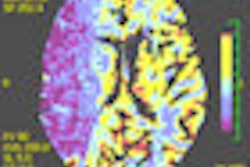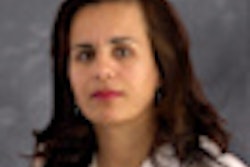
In the acute care chain of neurological patients, stroke is an excellent example of successful cooperation between emergency medical staff and other hospital colleague and how technology enhances information flow, a Finnish expert said on Tuesday at the World of Health IT (WoHIT) and eHealth Week 2012 meeting in Copenhagen.
Stroke patients have a high urgency code for transport to the hospital when there is a potential need of thrombolysis treatment, explained Dr. Tiina Sairanen, PhD, a neurologist at Helsinki University Central Hospital (HUCH). This treatment for ischemic stroke patients in Helsinki is a top benchmark in Europe, according to the European safe implementation of thrombolysis in stroke (SITS) registry, due partly to proper identification of candidates by the emergency team. In the Finnish capital, almost one-fifth of all ischemic stroke patients receive thrombolysis, while the European average was only approximately 5% in 2005.
"An increasing number of European countries have an electronic communication system connecting ambulances and the emergency room (ER)," outlined Sairanen, who is head of the outpatient clinic of the department of neurology at HUCH.
 More European nations now have electronic communication systems connecting ambulances and the ER, according to Dr. Tiina Sairanen, PhD.
More European nations now have electronic communication systems connecting ambulances and the ER, according to Dr. Tiina Sairanen, PhD.It has become increasingly important to have systems that communicate and transfer patient data such as ECGs and other vital information. A video can be sent of the patient's condition for evaluation by an emergency physician located either at the headquarters of the emergency medical staff (EMS) or at the receiving hospital. Inside the hospital, patient details are communicated from the ER to the hospital ward.
"In general, the ECG evaluation and the decision to start thrombolytic therapy outside the hospital is a good example of working electronic communication between the EMS on-site and emergency physicians off-site. Electronic patient data from the site can also help in deciding whether the patient needs to be admitted to hospital emergency," she said. "At HUCH's ER, with its catchment area of 1.5 million, a secured electronic data transfer system between the EMS and hospital has been piloted and adapted for use."
Sairanen presented data from the Finnish Telestroke Network, a physician-driven and publicly funded teleconsultation system. Since 2007, about 250 thrombolysis treatments have been given through that system to patients treated in community hospitals that have a stroke unit but no neurologist available 24/7. Telestroke consultations are bidirectional audio-visual contacts through a dedicated wideband Internet connection capable of transmitting DICOM brain scans. Literature shows similar technological approaches for evaluation -- by a neurology consultant -- of radiology and dermatology images, psychiatric consultation, and evaluation of movement disorders. Financing of the equipment and specialist time resources may raise key issues, however.
Regional PACS networks allow evaluation of radiological scans by a radiologist or ER specialist between Finnish hospitals, helping to avoid transfers of patients. And about two-thirds of referrals to HUCH's outpatient specialist clinics are carried out electronically -- further examples of how information and communications technology, or e-health, serves to improve efficiency and quality of care, stated Sairanen, who was coordinating writer of the working group for the Finnish Current Guidelines in Ischemic Stroke. In 2010, she received the European Stroke Organization (ESO) master degree in stroke medicine from the Danube University, Krems, Austria.
Between 7 and 9 May, policymakers, physicians, hospital CEOs, and chief information officers, as well as representatives from payer organizations, attended the meeting in Copenhagen. The Danish capital hosted, in conjunction, the annual High Level Ministerial eHealth Conference, the eHealth week, and the World of Health IT conference and exhibition. According to a statement from the European Commission, e-health is a recognized tool to enhance the modernization of national healthcare systems. Europe at national as well as cross-border level is facing challenges such as an aging society, chronic disease management, patient and professional mobility, and health professional shortages, that e-health could help to improve -- hence the need for a combined effort to spread the message, it stated.
Patient empowerment was a central theme of the congress. Neelie Kroes, vice president of the European Commission, said patients can do more than just passively consume healthcare. Simple information and communication technology tools can put health choices into their own hands; they constitute a system that is both more cost-effective and more empowering, she said.
"The time of doctors talking down to passive patients is over," added John Dalli, European Commissioner for Health and Consumer Policy.
For a healthcare portal to succeed, Morten Elbæk Petersen, CEO at the Danish health portal sundhed.dk, thinks three challenges must be addressed: health professionals need to let go of control, and patients must take control of their disease; the traditional hospital experience must change; and some aspects of it deny the patients' empowerment.
"What if the result is surprising and the empowered patients don't do what we want? There are limits to patient empowerment," he commented. The system needs to move from a professional-oriented to a patient-oriented presentation of data, he added.
In Estonia, patients are at the forefront of empowerment. The national e-health system gives them online access to their own data -- discharge letters, ambulatory care summaries, and test results. They can declare intentions and preferences. ID cards secure access to the systems, and all attempts to view data are monitored by patients and by the Estonian eHealth Foundation. The country has formed an ethics committee to lead the discussion on patient rights. This body has suggested an opt-out system that eliminates the need for patient consent while sending the data; however patients can deny access.
Estonia has seen a slow but steady growth in the use of health information systems, said Kelli Podosvilev, board member of the Estonian eHealth Foundation. A total of 6.7 million documents are on the system for 68% of the population (more than 800,000 people). About 90% of hospitals' discharge letters are digital. The information is available in iPatient, which has seen a sharp rise in user numbers, Podosvilev noted.
"Users are mainly young women between 21 and 40 years. Unfortunately, we don't see many male users," Podosvilev said. For young, healthy women, one of the main uses for iPatient is to view ultrasound images of their fetuses. Other age groups follow when doctors take an active role in motivating patients to use the system, concluded Podosvilev.
E-health is all about connecting people and empowering citizens to take control of their own health, said Nicole Denjoy, secretary general of COCIR (European Coordination Committee of the Radiological, Electromedical and Healthcare IT Industry), which supported the meeting.
"It remains key to learn from best practice and work collaboratively on the concrete deployment of e-health solutions. This will only be possible if all actors work together. While facing the economic crisis, we should be smart in optimizing the use of EU Structural Funds for better and faster deployment of e-health at country and regional level," she added.
To coincide with the Copenhagen event, the organization published the second edition of the COCIR eHealth Toolkit: Contributing to the European digital agenda. Click here to read it.



















